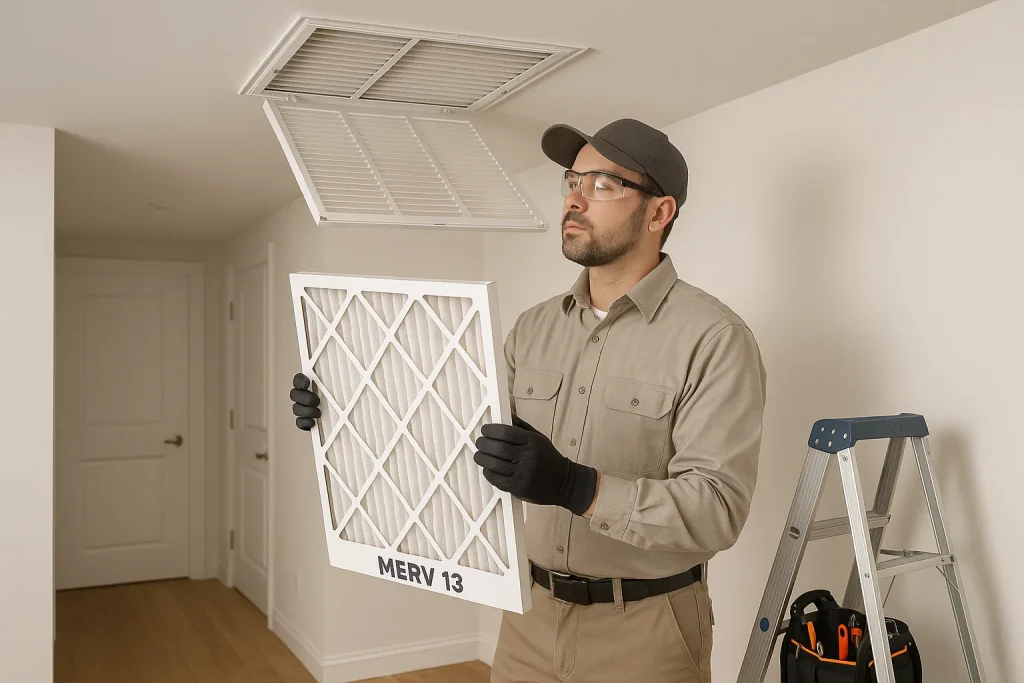Indoor air quality significantly affects your family’s health and comfort. Pollutants such as dust, pet dander, mold, and volatile organic compounds (VOCs) can circulate unnoticed inside your home, triggering allergies, asthma, and other respiratory issues.
The good news is that improving your indoor air quality doesn’t require expensive equipment or major renovations. With some simple habits and smart choices, you can breathe easier and create a healthier living environment for everyone. Here are ten practical tips to boost your home’s air quality.

1. Change Your HVAC Filters Regularly
Air filters trap dust, pollen, and other airborne particles. Over time, clogged filters reduce airflow and allow contaminants to circulate. Replace or clean your HVAC filters every one to three months, depending on usage, to maintain good filtration and system efficiency.
2. Keep Your Home Clean and Dust-Free
Regular dusting and vacuuming reduce allergens that settle on surfaces and carpets. Use a vacuum with a HEPA filter to trap fine particles. Don’t forget to clean curtains, upholstery, and bedding frequently, as these fabrics collect dust mites and pet dander.
3. Use Exhaust Fans in Bathrooms and Kitchens
Moisture from cooking and bathing encourages mold and mildew growth. Using exhaust fans helps remove excess humidity and odors, preventing mold spores from spreading through your home’s air.
4. Control Indoor Humidity
Ideal indoor humidity levels are between 30% and 50%. Use a hygrometer to monitor levels, and run dehumidifiers or humidifiers as needed. Proper humidity control prevents mold growth and dust mite proliferation, both of which harm air quality.
5. Ventilate Your Home Regularly
Open windows and doors when weather permits to introduce fresh outdoor air and dilute indoor pollutants. Cross-ventilation—i.e. opening windows on opposite sides of your home—maximizes airflow and helps flush out stale air.
6. Avoid Smoking Indoors
Tobacco smoke contains numerous harmful chemicals that severely degrade indoor air quality. Designate outdoor areas for smoking to protect your family from secondhand smoke exposure.
7. Choose Low-VOC or No-VOC Products
Paints, cleaning supplies, and building materials often release volatile organic compounds (VOCs) into the air. Select low- or no-VOC products and store chemicals safely to minimize these indoor pollutants.
8. Use Air Purifiers with HEPA Filters
Portable air purifiers equipped with HEPA filters can capture tiny particles, including allergens and some bacteria. Place purifiers in bedrooms and living spaces where you spend the most time for maximum benefit.
9. Maintain Your HVAC System
Schedule annual professional HVAC inspections and cleanings. Well-maintained systems run efficiently, circulate cleaner air, and reduce the risk of mold or bacteria growth inside ductwork.
10. Reduce Clutter and Choose Easy-to-Clean Furnishings
Cluttered spaces and heavy fabrics trap dust and allergens. Opt for minimal decor, hard flooring instead of carpet, and washable window treatments to make cleaning easier and more effective.
Final Thoughts
Improving indoor air quality is an ongoing process that pays off in better health and comfort for your family. By adopting these 10 simple tips—ranging from regular cleaning and ventilation to smart product choices and HVAC maintenance—you can create a fresher, cleaner indoor environment without major expense.
Since 1971 customers have trusted Coventry & Gattis A/C, Inc. to keep their homes safe and comfortable. Contact us today!
